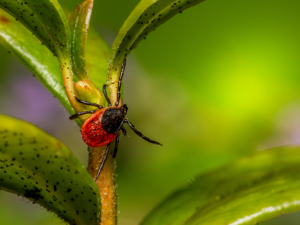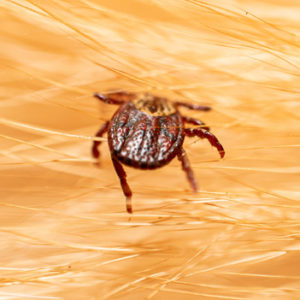Protect Your Family, and the Environment with Effective, All Natural Tick Control

According to the Centers for Disease Control and Prevention (CDC),
- U.S. cases of tick-borne diseases have more than doubled from 2004 to 2018, with over 50,000 cases reported in 2018.
- The most common tick-borne disease in the United States is Lyme disease, accounting for approximately 82% of all reported cases in 2018.
- Seven new tick-borne pathogens were discovered in the U.S. Between 2004 and 2016
- The CDC estimates that around 300,000 people are infected with Lyme disease annually, with only a fraction of cases being reported and diagnosed correctly.
- A 2021 study found that black-legged ticks (Ixodes scapularis), which are responsible for transmitting Lyme disease, have expanded their range by nearly 45% since the 1990s.
This increase has been attributed to factors such as climate change, reforestation, and the growth of suitable habitats for ticks.
This comprehensive guide on all-natural tick control solutions will help you create a safe outdoor space for your loved ones while protecting our valuable bee population. Discover how easy it is to maintain a bee-friendly yard without compromising your family’s well-being, even in areas where tick populations are thriving. By implementing eco-friendly and effective tick control methods, you can enjoy the outdoors with peace of mind, knowing that you are protecting both your family and the environment.
Bee Friendly Pest Control is committed to offering pesticide-free, all-natural, and organic solutions that help you tackle fleas, ticks, and mosquitoes without disrupting nature’s delicate balance. Our eco-friendly treatments are designed to safeguard your family, pets, and the environment from these potentially hazardous pests.
What are ticks?

Ticks have a complex life cycle, consisting of four stages: egg, larva, nymph, and adult. They require a blood meal at each stage (except for the egg) to grow and develop. Ticks are vectors for numerous diseases, such as Lyme disease, Rocky Mountain spotted fever, and babesiosis, which they can transmit to humans and animals through their bite. The black-legged tick, for example, is the primary carrier of Lyme disease in the United States.
Ticks locate their hosts by a behavior called “questing,” where they climb grasses, shrubs, or other vegetation and wait for a host to pass by. When a potential host brushes against the vegetation, the tick grabs onto it and begins searching for a suitable spot to feed. Ticks prefer dark, moist areas on their host, such as the back of the knees, the groin, or the hairline.
Controlling tick populations in your yard is essential for minimizing the risk of tick-borne diseases for your family. The presence of ticks can cause stress and anxiety, especially for parents with young children who enjoy playing outdoors. Additionally, ticks can also be brought indoors by pets, increasing the chances of encountering them in your home. By implementing effective tick control measures, you can significantly reduce the number of ticks in your outdoor spaces, providing a safer environment for your family and pets.
Where are ticks living in my yard?
Ticks thrive in tall grass, leaf litter, and wooded areas, so it’s crucial to understand the conditions that favor their survival to help control their population. They are sensitive to temperature and humidity, requiring a specific range of conditions to remain active depending on the region. . Ticks are most active during warmer months, particularly from April to September, but can also be active in milder winter temperatures. Knowing when ticks are active in your area can help you implement timely tick control measures, further safeguarding your family from potential health risks.
While ticks are a genuine concern for many households, it’s essential to recognize that not all ticks carry diseases. However, it’s always better to err on the side of caution by taking necessary precautions and reducing the chances of tick exposure. Understanding the types of ticks in your region, the diseases they may carry, and their behavior can help you make informed decisions about the best tick control methods for your yard.
Significant Health Risks
Lyme Disease
Lyme disease is a tick-borne illness caused by the bacterium Borrelia burgdorferi. When infected ticks transmit Lyme disease through their tick bites, it can lead to various health problems if left untreated. Symptoms of Lyme disease often include fever, fatigue, headache, and a characteristic “bull’s-eye” rash.
If not promptly addressed, the disease can progress and affect the joints, nervous system, and even the heart, causing serious complications. Effective tick control measures and tick prevention strategies, such as wearing protective clothing and using insect repellents, can help minimize the risk of Lyme disease and tick infestations.
Tularemia
Tularemia, also known as rabbit fever, is a bacterial infection caused by Francisella tularensis. This disease can be transmitted through tick bites, contact with infected animals, or inhalation of contaminated air.
Tularemia can cause a range of health problems, including fever, chills, fatigue, and skin ulcers at the site of infection. In severe cases, it can affect the lungs and lead to pneumonia. Although tularemia is relatively rare, it shows the importance of tick control and tick prevention to avoid exposure to infected ticks and reduce the risk of this serious disease.
Babesiosis
Babesiosis is a tick-borne illness caused by microscopic parasites of the genus Babesia. It’s transmitted to humans through the bites of infected ticks, most commonly black-legged or deer ticks.
Health problems associated with babesiosis often include fever, fatigue, and muscle aches — although severe cases can lead to complications such as anemia and organ damage. Tick control measures and tick prevention are crucial in regions where babesiosis is prevalent, as they can help reduce the risk of tick infestations and the transmission of this disease.
How Can I Prevent Future Infestations?
There are many ways that you can take proactive measures to prevent future tick infestations and reduce the risk of tick bites. To effectively manage tick control on your property, you should start with regular yard maintenance — keeping lawns well-trimmed and eliminating tall grasses and overgrown vegetation can help remove tick habitat and reduce the presence of tick populations. Additionally, creating a barrier between wooded areas and living spaces, such as installing gravel or wood chip borders, can discourage ticks from encroaching.
Homeowners can also utilize insect repellents on exposed skin and clothing to repel ticks when venturing into tick-prone areas, particularly during tick season. Wearing long pants and sleeves can further reduce the risk of tick infestations. It’s vital to conduct a thorough inspection of the body and clothing after outdoor activities, focusing on areas where ticks are likely to latch on, such as pant legs and sock cuffs. Prompt tick removal using fine-tipped tweezers is essential to prevent disease transmission.
For more comprehensive tick prevention, you should consider consulting with our professional tick exterminators to assess and address potential tick infestations in your yard. Our experts can recommend and implement appropriate tick treatment strategies to target specific tick species in the area, reducing the overall tick population.
Our Tick Exterminator Team Is Happy to Help in the Following Areas and Beyond
- Philadelphia Suburbs
- Camden County
- Gloucester County
- Burlington County
- Collingswood
- Voorhees
- Deptford
- Mount Laurel
- Burlington
- Cherry Hill
- Haddonfield
- Medford
FAQ
Can ticks be permanently exterminated?
Unfortunately, ticks are resilient pests that are challenging to permanently exterminate from a property. While professional tick exterminators and pest control services can help reduce the tick population in a specific area, complete eradication is often very difficult.
Ticks have various hosts and habitats, making them persistent in wooded areas, tall grasses, and even urban environments. As a result, regular maintenance and tick prevention efforts are important for keeping tick populations in check and preventing future infestations.
Is it worth spraying my yard for ticks?
Deciding whether to spray a yard for ticks depends on several factors, including the local tick season, the presence of tick-prone areas like tall grasses, and the overall risk of tick infestations.
While the use of insecticides to repel ticks can normally be harmful to the environment and the health of other pets and animals in the area, our all-natural and synthetic pesticide-free solutions will ensure that ticks are kept safely at bay. Our yard treatments can be effective in reducing tick numbers and helping to prevent ticks from infesting your property.
What are the symptoms of Lyme Disease?
The signs and symptoms of Lyme disease vary and can include fever, fatigue, joint pain, and muscle aches. The hallmark sign is the erythema migrans rash, which often resembles a bull’s eye. However, not everyone with Lyme disease develops this rash.
If left untreated, Lyme disease can lead to more severe symptoms, affecting the joints, heart, and nervous system. Early detection and prompt tick removal are of utmost importance when experiencing these symptoms, as ticks can transmit Lyme disease.
Do all ticks carry Lyme Disease?
While ticks are capable of transmitting a range of tick-borne diseases like Lyme disease, not all of them carry the bacteria responsible for the disease. There are two types of ticks that can transmit Lyme disease, including the Ixodes scapularis, also known as a deer tick or blacklegged tick, as well as the Ixodes pacificus, more commonly known as the western blacklegged tick.
Keep Your Family Safe with Bee Friendly Natural Pest Control
While ticks are a common problem in many households, you can keep them out of your home with Bee Friendly Pest Control’s range of natural tick yard control treatments. Whether you have an infestation or want to protect your family, we’re here to help with our innovative and safe solutions. Contact us at 1-888-4BEE-LUV to schedule an appointment today!
